[Trade Journal]
Publication: American Institute Of Electrical Engineers
New York, NY, United States
p. 215-230, col. 1
THE BAY COUNTIES POWER COMPANY'S
TRANSMISSION SYSTEM.
BY L. M. HANCOCK.
In treating of this subject it is taken for granted that the majority are familiar with the details of the Bay Counties Power Company's system which now forms a less important part of the plant of the California Gas and Electric Corporation.
Only an outline of the general and controlling features will be given, dealing more at length with the organization of the forces to operate the plant and to carry on construction and repairs. Considering organization, the plant falls into the following three natural divisions:—
Generating.
Transmitting.
Distributing.
The first comprises all water systems and power houses. The second, all high potential transmission lines and their fixtures. The third, all substations and low potential lines and their fixtures.
The main features of the plant and the attention they require are as follows:
Diverting Dam. Log crib, rock filled, 40 feet high and about 200 feet long on the crest. The intake and headgates were of concrete and very massive and ruggedly substantial throughout. The dam needed and could get attention only during periods of low water; then it was examined thoroughly each year and whatever repairs were necessary were made preparatory to another season's submergence which lasted the greater part of the year. The gates and intake needed some attention which was all given by the flume men.
Main Flume. Seven feet wide, six feet deep, seven and one-half miles long, through one of the most rugged pieces of canyon in the State. This was the most difficult part of the system to construct on account of inaccessibility. It was also one of the most difficult parts of the system to keep up to a high standard of repair, and on ccount of local conditions must be very carefully watched to avoid danger and to care for the numerous accidents as they arose. It must all be inspected each day to take care of many little things that needed prompt and immediate attention though the main repair work was attended to once a year.
The Main Penstock at the end of this great flume was built of concrete and besides receiving water from the main flume was arranged to be fed in an emergency with water from Lake Francis, through 9000 feet of 36-inch wooden stave pipe, 1/2 mile of natural channel and 3000 feet of rapid flume. This penstock delivers water to Colgate and to the old Brown's Valley irrigation system. On account of previous troubles with the pipe lines, variations in the flow of water, and the great dependence put on this plant, watchmen were stationed at the penstock and held there constantly.
The Five Thirty-Inch Pipes carry the water from the penstock and deliver it into the receivers back of the power house. These pipes were very carefully installed and need only an occasional inspection, which is given by the power house superintendent or foreman after severe storms early in the spring and late in the fall.
Being covered for the greater part of the way, this inspection of course only takes in exposed portions and surface indications, leaks, conditions of retaining walls, breakwaters, etc.
Water is distributed from the receivers to the 16 water wheels through small pipes and suitable gates. All the small pipes, connections, gates, etc., near the power house get regular attention from the forces employed there. Inspections are frequent and every item has continual care.
The power house equipment is as follows:--
 |
Suitable tangential water wheels with deflecting nozzles are directly connected to each generator and exciter. The low-potential switching is made as simple as possible and only such instruments are centralized as are needed to control the plant. The balance are scattered about the building near the apparatus to which they belong. Oil switches are used exclusively for the 2400-volt circuits, at which voltage all the machines operate. The Transformers are all oil-insulated and water cooled, the majority of them are 750 kw, but there are a number of smaller sizes. They all require almost no care and being in the power house have constant attention.
All low-potential wires and cables are run in a subway, while all the high potential wires and connections are overhead in the gallery. Originally an immense amount of wood was used in mounting the high-potential switches, lightning arresters, etc.
This construction was all destroyed in a fire, March, 1903, and has been replaced by a brick and tile and steel construction built up on the cellular system.
The unique feature of Colgate is the number and variety of very high potential circuits radiating from the plant. The following table gives a list of them:—
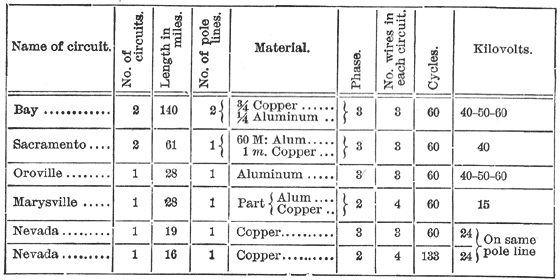 |
This variety of service can only be handled successfully at the power house end by either using individual transformers for each line, by using a great many high-potential switches, or a combination of the two methods. The first, however, makes it necessary to have a great deal more transformer capacity than is necessary for the loads handled. The second method was pioneering to an alarming extent. Therefore the third method was adopted planning to use as few of both devices as possible. The odd phase and voltage lines had to have separate transformers which were operated from the low potential switches and were to all intents and purposes a part of their respective lines. The growth of the plant was such that the odd voltage three-phase lines could not be avoided; however it was planned ultimately to have these all operated at the same tension.
The question of high-potential switching was one of very great moment and must be solved, yet it is not to be trifled with.
There were four designs of switches employed, as follows:
First, an emergency switch, which when open or closed was perfectly safe but would not stand being opened under full voltage and heavy current. This was simply a blade about thirty inches long with jaws mounted on large insulators which were carried and held in place by suitable frame work, the blades being pivoted to one of the jaws. These switches were suitable for cutting out a dead line or would open the full voltage of a thirty mile line if there were no load on it. They were also adapted for cutting in and out banks of unloaded transformers but with full voltage on. They were used in series with main switches, lightning arresters and other devices that must be taken out of service occasionally without having to shut down, and were also employed for temporary work and testing.
Second, the Stanley switch, which was arranged to break the arc in a tube filled with plaster paris. This served the purpose in the absence of anything better, but was clumsy, slow of operation and often out of repair.
Third, the oil switch with horizontal break. This switch was not installed where it had to handle heavy loads, but there were some very severe tests put on it which it stood remarkably well. These tests consisted of opening a dead short at a distance of 100 miles from Colgate with full generator capacity behind the line.
Fourth, the oil and water switch. This switch in its original form was put under extremely severe tests which it stood wonderfully well, opening 25 dead shorts on a 40 K.V. line in quick succession, some of which were 240 miles from the generator via the pole line. However the design of this switch was not suitable to the duties required of it. During a severe lightning storm it broke down and was not replaced. The consensus of results pointed to the horizontal break oil switch as the one that stood the test of actual service the best of any.
The Substations and the wiring for them were as various as could be imagined. The transformers as a general thing were wound so that they could be used anywhere on the system, and taps were brought out so that either three-phase or two-phase circuits could be fed from them. Three transformers were generally used and taps were brought out from the winding so that the voltage could be varied as needed. When two-phase service was given from three transformers, it was found unsatisfactory for motor work on account of the regulating coils varying the phase angle. In several cases a single transformer was installed for single-phase service in small towns, the high-potential side having one wire attached to one of the line wires and the other to a ground plate, very satisfactory service being given in this way in small towns.
The substation buildings varied from steel frames covered with corrugated iron in important locations, to an ordinary wooden building in some of the small towns.
The Switchboards in a few of the larger stations were quite complete, but in the majority were very simple, there being generally apparatus to meet only the most urgent needs. High-potential switches were usually provided in each station; in the larger ones they were either Stanley or horizontal oil break; in the smaller stations, the cheapest kind of a long knife switch. Devices were usually provided outside to cut the line clear from the building. Ten substations were put into service when the line went into commission. In three years this number had increased to twenty-six. The majority of these stations needed little attention.
The organization of the forces to operate this system was a most difficult task. There was no experienced class to draw from so men had to be educated for the work, and meanwhile the system had to be kept going. There must be more men than was actually necessary, yet in the trying out of so much new apparatus there was no telling how many men would be needed for emergency work. There must be no delays in repairing breaks for financial men the country over were watching the results and a little parsimony might mean thousands of dollars lost in depreciated securities.
The water system consisted of the following items in the order of their importance:
First: Main section, dam, flume, and penstock.
Second: Auxiliary section, Lake Francis system.
Third: The middle section from Colgate penstock to the Brown's Valley power house.
Fourth: The lower section below the Brown's Valley power house.
The Lake Francis auxiliary system is placed second in order of importance, though as it exists it is not worthy of the place for it is so far removed and the conduits are so small that it does little good as an auxiliary. The writer urged very strongly when the original plans were made that they provide a penstock reservoir of sufficient size to operate the plant for a few hours at least. Had this been done the operating expenses of the hydraulic system could have been kept at less than one-half of what was found to be necessary. In other words, an average of ten men are now needed if the system is kept up to the proper standard, while with the reservoir only four would be needed; a saving of $5,400 per year which capitalized at 5% equals $108,000.
This sum, plus the actual cost of the Lake Francis system would have been amply sufficient to put in the reservoir suggested.
This is an excellent illustration of how the design may affect the future operating expenses.
The conditions facing us were these: The system as installed must be utilized to its fullest extent and at the least cost. With this understanding the following organization was adopted:
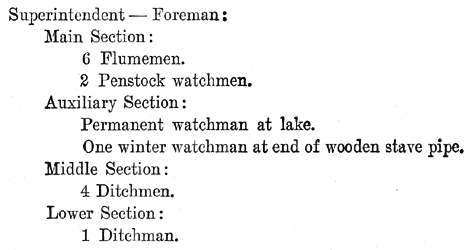 |
This force handled all the work well except the yearly repair work and eases of extreme emergency. Then extra men were brought in from other parts of the system or from outside sources.
While the flume was new there was no great trouble in making the natural repairs, but as it grew older, timbers began to rot, twist, and crack and repairs of magnitude had to be made. Many places were patched up and from the very nature of things had to be left till an opportunity came for thorough work. As long as the planking that actually held the water remained intact the balance of the repairs could be made with extra care and expense, but when a rock would come rolling down the hill and knock out the under-pinning or smash a hole through the flume itself, it was simply a case of shut down till damaged parts could be replaced.
This shutting down of 10,000 horse power, even for a few hours, was no idle matter and a thing every one dreaded.
The superintendent of the water system held an anomalous position; while taking his orders from the general superintendent direct, he must at the same time take orders from the Colgate superintendent in regard to the water furnished for the power house.
He must get over the whole of his system at least every month and must be on hand to take care of any emergency that might arise on the main flume, and there were many places on this important section that had to be watched continually in order to meet difficulties half way.
The foreman devoted all of his spare time on the main section, supervising repairs, looking after the placing of new material, maintaining discipline and ever holding himself in readiness for emergencies. The six flume men did little but patrol the flume; minor details they took care of however and always helped in cases of an accident. Two men were kept on watch at the penstock all the time.
These could do but very little except to stop any leak that might occur in the neighborhood, keep rubbish off the rack at the entrance to the penstock and attend to the adjustment of the various gates in the neighborhood. If there were a break in the flume, one or both were expected to assist in its repair. There was an elaborate system of floats and electric bells installed for detecting low water at various points a mile or more above the penstock but these devices were seldom of any value except to talk about.
When anything happened of a serious nature, the water always slacked away so quickly that everything, flume, penstock and all was emptied before the water wheel nozzles could be closed.
There were 14 gates to close these nozzles, each gate requiring ten minutes to operate it; hence with only three men on shift to do this it was quite a simple matter to predict what would happen.
On the middle section four ditchmen were employed who did practically all the repair work on their beats besides making their tour of inspection each day. This part of the system consisted of 20 miles of ditch and flume. It carried only 1,200 inches of water and was an old settled piece of work.
The lower section of the water system consisted of 22 miles of ditch and a few short flumes and inverted syphons and as it furnished only some irrigation water and some little desultory mining, it was of so slight importance that one man handled it successfully. Each year a force of from ten to twenty men were put on for a few weeks doing general repair work. At this time every feature of the system got an overhauling and whatever repairing it needed. Thus the whole system was put in readiness for another year of hard service.
The handling of this water system while very exacting, involved nothing new or strange. Materials such as men were familiar with were used and the handling of flumes was no new work for Californians with but this one exception; for power purposes without any storage, the full head must be kept running all the time, while the ordinary service to which flumes are applied water can be turned out at any moment it may be desired without causing any serious trouble.
The water system was peculiar in that none of the men ever saw any of the customers of the company and in fact seldom saw any but their immediate fellow workmen. Their cabins were in very isolated places and they seldom met any of the officers of the company. Theirs was a monotonous life with but little to inspire them. Their business was to deliver water and as long as that was done no one complained nor did they praise.
The Colgate power house was the center of the whole system and the whole aim of the operators was to put out energy.
This was dependent, (a) on the water system delivering water to them; (b) on their ability to utilize it and to keep in working order the apparatus in their care; (c) on the line department keeping the lines in order, to transmit what they generated; and (c1) somewhat, on the distribution system being able to receive and deliver to the customers what the line department handed over to them.
After the power house force had kept its apparatus in repair and in operation, they must, in order to succeed, be in harmony and in close touch with all the other parts of the plant. Hence the emphasis on a complete and efficient system of communication. This was not so evident on the water system, for immense systems of flumes and ditches have been and are operated without any means of communication other than messenger or mails.
Items (a), (b) and (d) did not interest the power house force; they must concentrate on their own troubles.
The principal item on which success depended here was the repairs of damaged or worn-out apparatus, so in order to facilitate this a large supply of new material and spare parts were kept on hand and a large and well equipped machine shop was installed and men were appointed on the force that could utilize these tools to their full value.
The forces here, though dependent so much on the others for success, were never allowed to get the idea of covering their own mistakes by attracting attention to the troubles of others. The handling of this power house had only these three features that distinguished it from all other large power houses.
First. It must feed numerous high voltage lines of various voltages, phases, cycles and lengths.
Second. It must run in parallel with other large plants that were many miles distant and operated at different voltage and phase.
Third. Its service reached almost every known business where power can be utilized, and there was not a moment in the year when a great many were not exceedingly anxious for energy.
While this was the case, the only feature of uncertainty at the start was that of the high-potential lines, switches, lighting arresters, etc., but after a year's experience it was found that to this apparatus could be charged no more than a proportionate share of the troubles.
It was decided that for Colgate there should be the following organization:
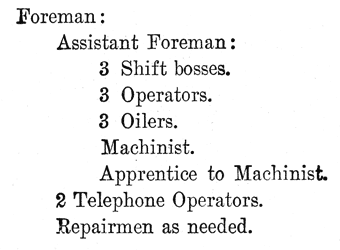 |
The superintendent, while not having absolute authority over the flume superintendent, in the one question of water supply his word was final. Besides this he was a man of much wider knowledge and experience which was all of very great value to the company and of which they wished the benefit. It was ordered that each should draw on the other in case of need and they must be in perfect harmony with each other. Besides having charge of Colgate, this superintendent had charge of a small power house of 1,000-horse power situated about nine miles distant and known as the Brown's Valley plant. On account of this, the Colgate and the water system superintendents were brought into still closer contact. The Colgate foreman had charge of all the day work, operating, repairs, new work, etc., and ranked next to the superintendent. The assistant foreman had charge of all the night work and ranked next to the foreman. The shift bosses were under the foreman and assistant foreman and had charge of the operation of the power house during their shifts.
They were directly responsible for everything that happened and the condition of the apparatus. They must see that everything was all right when they took charge and anything wrong when they came on duty must be reported at once else they would be held responsible. They were also responsible for the two men under them. Each shift was 8 hours and the operators were changed one shift ahead each two weeks. The machinist and his apprentice were free lances that had to do whatever was to be done at whatever time it was necessary. They did the greater part of repairing and proving of machinery.
The lines which have always been the "weak sister" demanded and got especial care and attention. It might be said on general principles that there never is enough money put into the lines.
We will deal alone with the 140-mile line, because this is typical of how all the others were handled, especially those carrying the higher potentials. The greatest care was taken in handling them, for they were unusually long and every move was watched with the keenest interest. Failures would receive the severest censure, because reaching to the very doors of San Francisco the service we were giving would be before the public in a much more important and effective way than anything we had yet handled. If the street cars of Oakland, which were the principal load at the start, did not run, the men who handled them and the public too were not slow to blame the trouble on the source of power. Hence every detail was studied and every plan possible carried out to get complete reports of the condition of the line every few hours of the day. Elaborate precautions were taken to discover any weakness and repair it before a break down could result. However, we could not always tell just how fast things were going to happen. There were three items that required attention:
First: The watching of the line and searching for weak places as they developed.
Second: The completion of the work which the construction forces had not the time to finish and the building of new branch lines.
Third: The repairing and changing of parts that were found to be faulty or unsuited to the conditions.
To attend to these the following plan of organization was adopted:
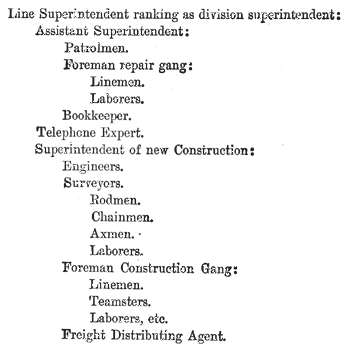 |
The superintendent of lines for the first year spent nearly all his time getting back and forth along the line, studying conditions as developments came, instructing the men, and keeping them up to their work. The importance of this work made great demands on the time of the general superintendent.
The assistant line superintendent devoted a good deal of his attention to the office work, checking reports, ordering and forwarding material, looking after the repair work, and working between trips with the line superintendent.
The telephone expert was in a position that he had to work under nearly all the superintendents though he was nominally under the line superintendent. His was a study in harmony. His work extended from one end of the plant to the other and as the name indicates devoted the greater part of his time to the solving of difficulties, designing and installing protective devices and working the telephone system so the highest efficiency could be obtained. He was always supplied with material and men on call. If communication could not be maintained, the plant could not be operated.
The superintendent of construction was utilized almost exclusively on new work, and hence had little to do with the operation of any of the lines, except when they first went into commission. He was expected to use every opportunity to study developments in order to assist in any way possible to the general success.
In order to care for the line thoroughly, patrolmen enough were put on so that they had an average of 14 miles to cover each day. In the mountains and marshes the beats were shorter and in the valleys longer.
The whole line must be put into shape so every part of it could be reached. In the hills trails must be dug, creeks bridged and barns built for horses. In the marshes and flooded lands boats must be provided, everywhere gates must he put in fences and above all certain communication must be provided.
The work required that the patrolmen should not do very much of the actual labor connected with the upkeep of the line. They carried a number of tools and a portable telephone and were always called on in emergencies. They must report on duty in the morning, get over their beat at a slow enough gait to be sure of the condition of every detail, report several times during the day and report off duty at night. Usually by the time they had attended to all the above, they had accomplished a very good day's work. Most of these men used saddle horses; in fact there were only one or two beats where a wheeled vehicle could be used to advantage. Material was stored at various places along the line so that it could be reached conveniently in case of trouble. The work of patrolling was so new that there was no class of trained men to draw from so each patrolman had to be educated. In fact the officers in charge had to make an unusually close study of it, living with it almost night and day for two years. A host of questions were asked and few of them answered before the line went into service. As the answers came they must be recognized quickly and the work pushed accordingly.
It looks a little strange to put on a repair gang almost before an installation has gone into actual service. This was on account of the work being so new that there was no experience to guide those who designed the various parts of the equipment.
Some of the questions to which we had to learn the answers in the field, were:
To what extent will the wooden supports of the line be destroyed by the high potential used?
How will the insulators, which were a composite glass and porcelain, stand the actual strain of operative conditions?
How much of the insulator can be broken off before it must be removed from the line?
How much dirt can accumulate on an insulator before it must be cleaned?
How noisy can an insulator get before it is dangerous? What effect will fogs produce?
What effect will rain produce?
If a line gets shut down in a rain storm, can it be started up again and with what difficulty?
How will long spans stand up?
What will be the result of using steel for line supports?
As the work progressed answers came to all of these about as follows:
Wood pins were destroyed by the hundreds near salt water; cross-arms a few, and poles only two or three in the course of three years' service.
Glass is not suitable for high-potential insulators under the conditions as they exist on this system. An all-porcelain insulator has been and is being substituted for the composite insulator as fast as conditions will permit, especially near salt water.
The insulator first installed had so little margin of safety that if it were broken at all it was ordered removed from the line.
If only a small piece were chipped out of the edge the risk was taken for a time.
The only place where we had trouble with the accumulation of dirt on insulators was near salt water and cement works.
There may be a good deal of noise at an insulator on a wood pin for many weeks and not much damage result, but it should be watched closely. With a steel pin and a wood cross-arm this noise will not be anything serious except in some unlooked-for place, due to local conditions. These should be watched closely on general principles.
Ocean fogs cause the burning of very many wood pins, while cross-arms and poles suffer but little. Fogs a few miles back from salt water do not affect either pins, cross-arms or poles.
Rain is Heaven's own blessing on a high-potential transmission line. It cleans the insulators and stops a good deal of the damage to wooden supports. This is true of salt water districts especially. The first few drops that fall after a prolonged dry spell causes a good deal of a display which soon passes however and all is quieter and better than it was before. This display does not affect the power house load to an appreciable extent nor does it affect lights or motors.
The starting of this line in a rain storm never caused the slightest trouble, in fact in changing from one line to the other full voltage has many times been thrown instantly on the dead line during heavy rain storms without the slightest disturbance that any one could detect.
The experience has been that long spans are preferable in almost every case. On a mountain line built about two years ago some very long spans were used. One was 1,800 feet with the regular line conductor, a 350,000 cm stranded aluminum cable, and it has given the best of satisfaction.
Every indication is that steel should be used for high-potential line supports from the ground up to the insulator throughout the system.
The substations and distribution work were handled almost entirely by the local men, nearly all of whom were under a separate management. A superintendent of this work was maintained whose duties were mainly to advise the local men in regard to the handling of the company's property and to see that it had proper care.
At the majority of the substations a man would be on duty only for a time during the evening when the lighting load was on, unless there was important high-potential switching to be done.
The low-potential distributing systems gave very little trouble and it was very seldom that they were not able to utilize the current available.
The men for all the positions were very carefully selected from the whole country. The repair and construction forces were used as training schools for men for permanent positions and the foremen of these gangs were selected with this specially in view. These forces were used too as places to lose out undesirable characters.
The following ideas were advanced to guide in the handling of the men:
First. Harmony must be maintained.
Second. There must be a definite sequence of authority to prevent working at cross purposes.
Third. Each man must respect and obey the officer immediately over him.
Fourth. Each man had the assurance that his advancement depended on himself alone; that all the higher positions of the operating, repair and construction forces were open to the men handling the plant if they would fit themselves for them.
Fifth. The longer the time of service the better the pay.
Sixth. A sufficient number of men must always be kept to insure excellent service, but there must never be so many that each man's time will not be fully occupied.
The officers and the sequence of their authority for the whole system were as follows:
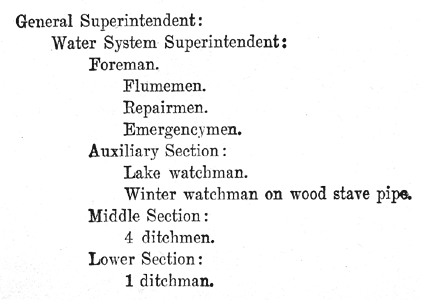 |
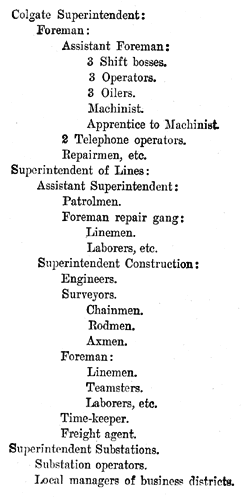 |
